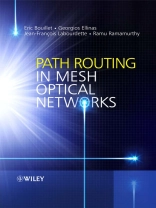Transport networks evolved from DCS (Digital Cross-connect
Systems)-based mesh architectures, to SONET/SDH (Synchronous
Optical Networking/Synchronous Digital Hierarchy) ring
architectures in the 1990’s. In the past few years,
technological advancements in optical transport switches have
allowed service providers to support the same fast recovery in mesh
networks previously available in ring networks while achieving
better capacity efficiency and resulting in lower capital cost.
Optical transport networks today not only provide trunking
capacity to higher-layer networks, such as inter-router
connectivity in an IP-centric infrastructure, but also support
efficient routing and fast failure recovery of high-bandwidth
services. This is possible due to the emergence of optical network
elements that have the intelligence required to efficiently control
the network. Optical mesh networks will enable a variety of dynamic
services such as bandwidth-on-demand, Just-In-Time bandwidth,
bandwidth scheduling, bandwidth brokering, and optical virtual
private networks that open up new opportunities for service
providers and their customers alike.
Path Routing in Mesh Optical Networks combines both
theoretical as well as practical aspects of routing and
dimensioning for mesh optical networks. All authors have worked as
technical leaders for the equipment vendor Tellium who implemented
such capabilities in its product, and whose product was deployed in
service provider networks.
Path Routing in Mesh Optical Networks
* Presents an in-depth treatment of a specific class of optical
networks, i.e. path-oriented mesh optical networks.
* Focuses on routing and recovery, dimensioning, performance
analysis and availability in mesh optical networks.
* Explains and analyses routing specifically associated with
Dedicated Backup Path Protection (DBPP) and Shared Backup Path
Protection (SBPP) recovery architectures.
As most of the core backbone networks evolve to mesh topologies
utilizing intelligent network elements for provisioning and
recovery of services, Path Routing in Mesh Optical Networks
will be an invaluable tool for both researchers and engineers
in the industry who are responsible for designing, developing,
deploying and maintaining mesh optical networks. It will also be a
useful reference book for graduate students and university
professors who are interested in optical networks or
telecommunications networking.
With a foreword by Professor Wayne D. Grover, author of the
book Mesh-Based Survivable Networks.
Giới thiệu về tác giả
Dr. Jean-Francois Labourdette is manager of system engineering at Tellium. He is responsible for all network element and network management system engineering activities. Before that he was manager of network routing and design, where he was responsible for Tellium’s routing architecture and algorithms, network dimensioning, and design studies.
Dr. Eric Bouillet is principal engineer at Tellium. He works on the design of optical networks and optimization of light-path provisioning and fault restoration algorithms. Before joining Tellium, Eric was a member of the technical staff in the Mathematical Sciences Research Center in Bell Labs/Lucent Technologies, working in the areas of routing in ATM and optical networks.
Georgios Ellinas is an Associate Professor of Electrical Engineering at City College of the City University of New York. Before joining City College, George was a senior network architect at Tellium Inc. In this role, he worked on light-path provisioning and fault restoration algorithms in optical mesh networks.
Ramu Ramamurthy is lead engineer in the Optical Switch Division at Ciena (Ciena’s Optical Switch has been deployed in the worlds biggest optical mesh networks). At Ciena Ramu works on the design and development of Routing and Restoration algorithms and protocols for optical mesh networks. Before that he worked for Tellium, where Ramu was part of a team that implemented Tellium’s routing and restoration algorithms for optical mesh networks. His work at Tellium has resulted in several patent applications, and he coauthored several widely referenced publications in leading journals and conferences.












